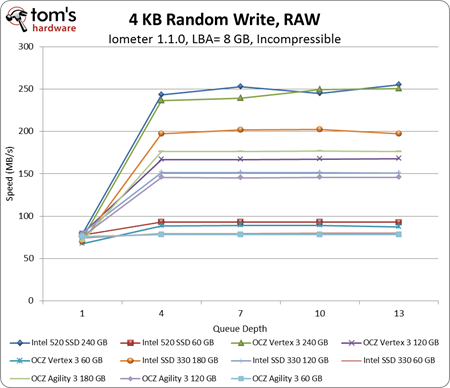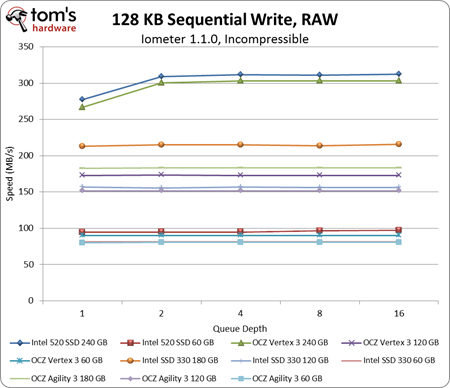Intel SSD 330 Review: 60, 120, And 180 GB Models Benchmarked
Benchmark Results: Incompressible Performance
SandForce's SF-2281 controller handles compressible data very efficiently, and the preceding page illustrates its best-case behavior nicely. However, the controller vendor openly admits that performance drops when it comes to addressing incompressible information. The proprietary DuraClass engine was designed under the assumption that most data is compressible. However, there are still plenty of workloads that involve incompressible information, too.
Incompressible Random Writes
All of the SandForce-based SSDs deliver between 70-80 MB/s when they're presented with incompressible data at a queue depth of one. Intel's SSD 330 starts at the bottom end of that range. It visibly suffers from whatever Intel did to handicap its performance.
From fastest to slowest, these SSDs are ranked in the following order:
- 240 GB SSD 520 and 240 GB Vertex 3
- 180 GB SSD 330
- 180 GB Agility 3
- 120 GB Vertex 3
- 120 GB SSD 330
- 120 GB Agility 3
- 60 GB SSD 520 and 60 GB Vertex 3
- 60 GB SSD 330 and Agility 3
The SSD 330 trails behind the SSD 520 and Vertex 3, as expected.
When it comes to comparing SSDs at similar capacity points, it is surprising to see the SSD 330 outrun OCZ's Agility 3. In fact, we notice that a higher-capacity mainstream product can actually outperform a smaller performance-oriented model. Here, it's the 180 GB SSD 330 delivering better benchmark results than the 120 GB Vertex 3.
Incompressible Sequential Write Performance
Get Tom's Hardware's best news and in-depth reviews, straight to your inbox.
Examples include copying/creating multimedia, archive manipulation, encryption, some gameplay, and video recording
Performance in incompressible sequential writes falls the same as it did in the preceding graph. The main difference here is that queue depth has almost no effect on measured performance.
Current page: Benchmark Results: Incompressible Performance
Prev Page Benchmark Results: 128 KB Sequential Performance Next Page Benchmark Results: Storage Suite v1.0 And PCMark 7-
Au_equus I bought this samsung 830 256gb ssd for $390 five-six months agoReply
http://www.newegg.com/Product/Product.aspx?Item=N82E16820147164
now its $275 or $1.074/GB. Better price/stability/performance than those listed above. -
phamhlam au_equusI bought this samsung 830 256gb ssd for $390 five-six months agohttp://www.newegg.com/Product/Prod 6820147164now its $275 or $1.074/GB. Better price/stability/performance than those listed above.Reply
Crucial m4 128GB from Newegg and Amazon @ 124.99. That is less than $1/GB. -
One question, which didn't explained: what Intel SSD is better for SATA 3Gb/sec 320 or 330 series?Reply
-
blazorthon Intel should have used non-SandForce controllers. The Vertex 4 (with the new firmware) shows what Sandforce alternatives are capable of, I hope that Intel's next flagship series does something similarly spectacular without Sandforce. I think that Intel could have used the 330s as a stepping stone to get a controller (such as a Marvell controller) up to Vertex 4-like performance (or better) in more universal workloads than Sandforce for their next flagship series.Reply
On that note, why weren't the Vertex 4s included in this review with the other drives? -
blazorthon EoveinOne question, which didn't explained: what Intel SSD is better for SATA 3Gb/sec 320 or 330 series?Reply
I don't think that it makes much difference at SATA 3Gb/s, but the 330s are faster drives, so they might be marginally better. -
blazorthon chimera201When will the price of SSD come down to HDD level? That would be news.Reply
Probably at least not until a cheaper memory than Flash is used in SSDs, so maybe ten to twenty years, if we're lucky. -
EDVINASM Am not a mad scientist or anything so I have missed something but to me Intel SSD is as good as any others on the market. I wouldn't see any difference in real world scenario between 330 and 520 or Samsung 830 or even M4. Who cares? I don't anyway. Just get the drive that you trust and that has reasonable warranty (3 years +) and good support. Done.Reply -
blazorthon edvinasmAm not a mad scientist or anything so I have missed something but to me Intel SSD is as good as any others on the market. I wouldn't see any difference in real world scenario between 330 and 520 or Samsung 830 or even M4. Who cares? I don't anyway. Just get the drive that you trust and that has reasonable warranty (3 years +) and good support. Done.Reply
Whether or not a part that is faster for your workloads than others and is faster enough to make a difference depends on what you are doing. If I was doing a lot of storage heavy stuff, like constantly downloading and decompressing large archives, then an SSD that can deal with in-compressible data very well would provide very noticeable gains over any SandForce drive or any lower end non-Sandforce drives. -
EDVINASM blazorthonWhether or not a part that is faster for your workloads than others and is faster enough to make a difference depends on what you are doing. If I was doing a lot of storage heavy stuff, like constantly downloading and decompressing large archives, then an SSD that can deal with in-compressible data very well would provide very noticeable gains over any SandForce drive or any lower end non-Sandforce drives.Reply
Fair point. Mind you, if you do that much and it's that important hardly any of standard (consumer grade) SSDs would interest you. Unless you are talking of downloading software and games from questionable sites, then yes - cheap and fast is cheerful.

